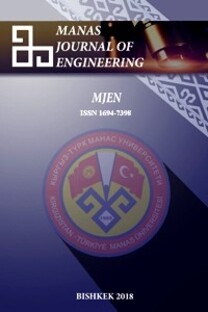Potential geoheritage assessment; Dereiçi travertines, Başkale, Van (east anatolian Turkey)
Dereiçi, travertine, geoheritage, Başkale Van,
___
- [1]. Kazancı, N., Özgen Erdem, N., Erturaç, MK., “Kültürel Jeoloji ve Jeolojik Miras; Yerbilimlerinin Yeni Açılımları”, Türkiye Jeoloji Bülteni, 60/1 (2017), 1-16.
- [2]. ProGeo Group., “A first attemt at a geosites frameworkfor Europe -an lUGS initiative to support recognition of World heritage and European geodiversity”. Geologica Balcanica 28, (1998), 5-32.
- [3]. Kazancı, N., “Dünyada ve Türkiye’de Jeosit-Jeopark-Jeomiras Olgusuna Yaklaşımlar”. Kızılcahamam-Çamlıdere Jeopark ve Jeoturizm Projesi Raporu”, (2010a) 76p, Ankara.
- [4]. Kazancı, N., “Milli Parklarda Jeolojik Miras 1, Soğuksu Milli Parkı (Kızılcahamam-Ankara)”, Çevre, Atmosfer, Yer ve Deniz Bilimleri Araştırma Grubu, (2007) 61p, Ankara.
- [5]. Kazancı, N., “Jeolojik Koruma (Kavram ve Terimler)”, Jemirko ve TMMOB Jeoloji Mühendisleri Odası Yayınları, (2010b) 60p, Ankara.
- [6]. Kazancı, N. ve Şaroğlu, F., “Türkiye Jeositleri Çatı Listesi”. 62. Türkiye Jeoloji Kurultayı (13-17 Nisan 2009) Bildiri Özleri Kitabı-I, Jeoloji Mühendisleri Odası, Ankara, (2009) 266-267.
- [7]. Gürler, G., Timur, E., “Jeoparkların Koruma Kullanım Yöntemlerinin Belirlenmesi; Karapınar Potansiyel Jeopark Alanı İçin Bir Değerlendirme, Türkiye”. Proceedings of The Second International Symposium on Development Within Geoparks Environmental Protection and Education, Lushan, Jiangxi Province, China, 12-15 June, (2007).
- [8]. Koçan, N., “Ekoturizm ve Sürdürülebilir Kalkınma: Kızılcahamam-Çamlıdere (Ankara) Jeopark ve Jeoturizm Projesi”. Karadeniz Fen Bilimleri Dergisi, 2/6, (2012a) 69-82, Trabzon.
- [9]. Gürler, M., “Doğal koruma alanlarının belirlenmesi ve planlanmasında jeoloji. JMO Semineri; Aynı yazı ve yazar”: Birlik Haberleri, Sh. (1997) 46-48.
- [10]. Gürler, M., “Ekolojik planlamada jeolojik oluşumlar için öneri bir sınıflama modeli”. TMMOB Birlik Haberleri, Mayıs-Haziran Sayısı, (1999), Ankara.
- [11]. Gürler, M., “Anıt nitelikli jeolojik oluşumlar ve koruma çalışmaları”. JMO Mavi Gezegen Popüler Bilim Dergisi, S. 4, (2001) 10-11, Ankara.
- [12]. Çiftçi, Y., Güngör, Y., “Jeosit Tanımlama ve Jeopark Düzenleme Standartları Üzerine Bir Çalışma”, 67. TJK. Bildiri özleri kitabı, (2014) p. 422, Ankara.
- [13]. Çiftçi, Y., Güngör, Y., “Jeopark Projeleri Kapsamındaki Doğal ve Kültürel Miras Unsurları İçin Standart Gösterim”. Maden Tetkik ve Arama Dergisi, 153, (2016) 223-238.
- [14]. Çiftçi, Y., Güngör, Y., “Jeolojik Miras Envanteri Hazırlamada Terminoloji, Yöntem, Kurumsal Sahiplenme ve Eşgüdüm”. 70. Türkiye Jeoloji Kurultayı Bildiri Özleri, (2017a), p. 620 - 621, 10-14 Nisan 2017, Ankara
- [15]. Çiftçi, Y., Güngör, Y., “Dünya'da ve Türkiye'de Jeolojik Miras Envanteri Hazırlama ve Jeokoruma Çalışmaları: Akreditasyon, Ulusal Kodlama Sistemi ve Etkileşimli Veri Tabanı Önerisi”. 70. Türkiye Jeoloji Kurultayı Bildiri Özleri, (2017b), p. 252 - 253, 10-14 Nisan 2017, Ankara
- [16]. De Lima, F.F.,Brilha, J.B., Salamuni, E., “Inventorying Geological Heritage in large territories: a methodological proposal applied to Brazil”. Geoheritage, 2, (2010) 91-99.
- [17]. Yılmaz, O.,. “Cacas bölgesi (Bitlis Masifi) kayaçlarının petrografik ve stratigrafik incelenmesi”. Türkiye Jeoloji Kurumu Bülteni, 18/1, (1975) 33-41.
- [18]. Tolluoğlu, A. Ü., “Mutki (Bitlis) yöresi metamorfiklerinin petrografisi/petrolojisi”. Yüksek Mühendislik Tezi, Hacettepe Üniversitesi, (1981), 86 p. Ankara (yayımlanmamış).
- [19]. Şengün, M., “Tatvan güneyinin (Bitlis masifi) jeolojik/ petrografik incelenmesi”: Doktora tezi, (1984). 157p. (yayımlanmamış).
- [20]. Göncüoğlu, M. C. ve Turhan, N., “Bitlis Metamorfik kuşağı orta bölümünün temel jeolojisi”. MTA Rapor No. (1985), 7707 (yayımlanmamış).
- [21]. Perinçek, D., “The Geology of Hazro-Korudağ-Çüngüş-Maden-Ergani-Elazığ-Malatya area”: Guide Book, TJK yayını, (1979), Ankara
- [22]. Perinçek, D., “Hakkari ili ve dolayının stratigrafisi, GDA Türkiye”: TPJD Bülteni, 2/1, (1990), 21-68.
- [23]. Yeşilova, Ç., Açlan, M., Güngör Yeşilova, P., “Van Gölü Çevresindeki Travertenlerin Jeoturizm Açısından Değerlendirilmesi”, Doğu Anadolu Jeoloji Sempozyumu , (2015), 252 - 253 p , Van, Türkiye , 07 - 12 Eylül 2015
- [24]. Ayaz, E., “Travertenlerde Gözlenen Morfolojik Yapılar ve Tabiat Varlığı Olarak Önemleri”. Cumhuriyet Üniversitesi Mühendislik Fakültesi Dergisi, Seri A-Yerbilimleri 19/2, (2002), 123-134, Aralık 2002
- [25]. ÇŞB., “Korunan Alanların Tespit, Tescil ve Onayına İlişkin Usul ve Esaslara Dair Yönetmelik”, (2012), Çevre ve Şehircilik Bakanlığı, Tabiat Varlıklarını Koruma Genel Müdürlüğü.
- [26]. ÇŞB., “Doğal Sit Alanlarının Değerlendirilmesine İlişkin Yönetmelik”, (2013), Çevre ve Şehircilik Bakanlığı, Tabiat Varlıklarını Koruma Genel Müdürlüğü.
- ISSN: 1694-7398
- Yayın Aralığı: 2
- Başlangıç: 2001
- Yayıncı: KIRGIZİSTAN-TÜRKİYE MANAS ÜNİVERSİTESİ
Technologies based on energy savings for OLED devices
Meryem Sena Akkus, Mohammed Albaba
Yavuz Selim Taspinar, Ilkay Cinar, Murat Koklu
Gözde KONUK EGE, Huseyın YUCE, Garip GENÇ
On some inequalities for derivatives of algebraic polynomials in unbounded regions with angles
A Gas Sensor Design and Heat Transfer Simulation with ZnO and TiO2 Sensing Layers
Garıp Genc, Huseyın Yuce, Gozde Konuk Ege
One Step Ahead Prediction of Ozone Concentration for Determination of Outdoor Air Quality Level
